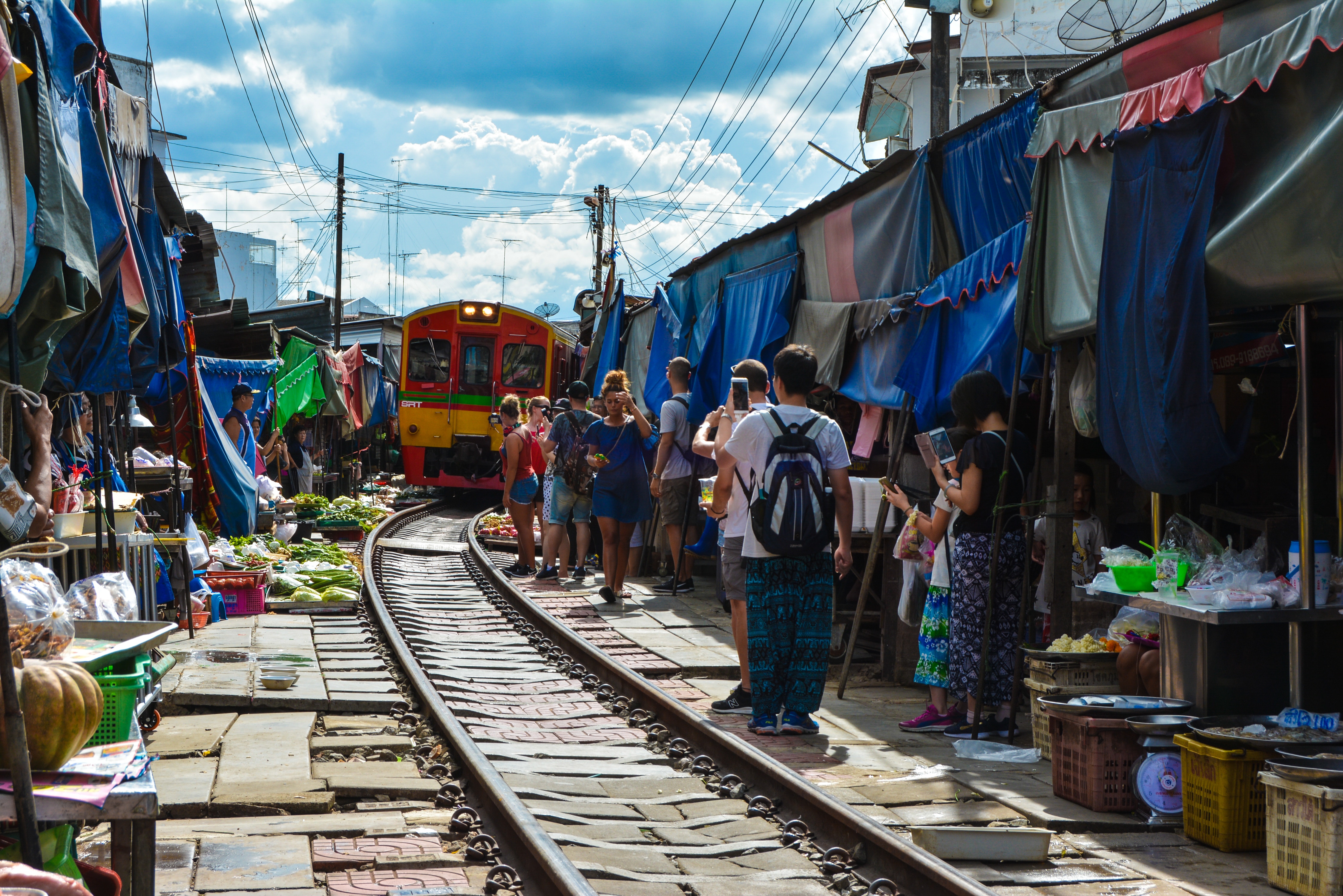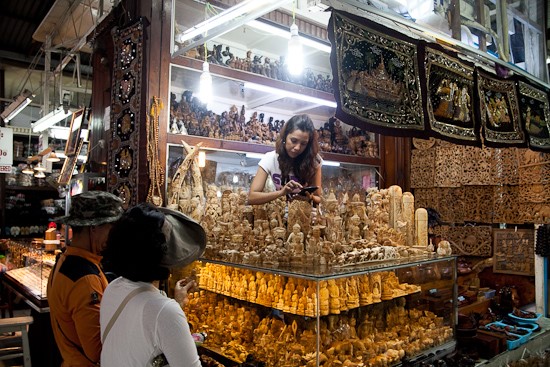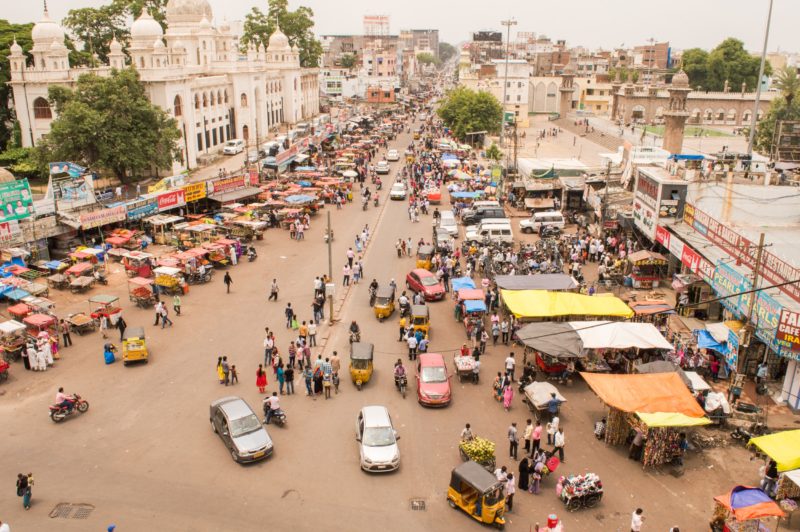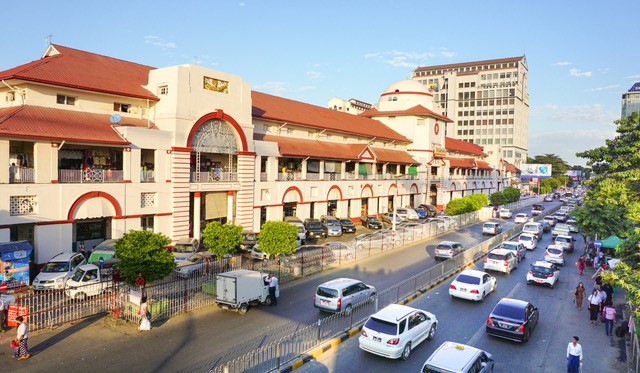Photo by Mukiibi John Elijah on Unsplash
***
In The Marketplace
by O. Alan Weltzien
My wife are I are on a mission as the taxi deposits us on Bogyoke Aung San Road, on the southwest corner of the Market by the same name—Yangon’s most famous market. I want to buy a ring.
About two-and-a-half years ago, on our first visit to Yangon, during our last full day I tried to buy a jade ring. The jeweler in a shop on a nearby street, one among many, had sized the gold ring for my finger but I couldn’t extract enough kyat from an ATM machine (due to daily transaction limit), so I never got that ring and the shop owner winced, his eyes sad, as several adjacent clerks stood by, commiserating.
I’d worn a gold jade ring belonging to my father, which he’d given me at least thirty years ago. My mother had given him this ring, the stone faceted from British Columbian jade, on an anniversary, maybe their silver anniversary. He died a score of years ago and I vowed, soon after his death, that when our older son turned eighteen he would inherit his grandfather’s ring, which he still wears. After my gift, the ring finger on my right hand tanned like the others, bereft.
Our daughter has lived and worked in Yangon for three years but is moving out of Myanmar, so I figure this is my best shot for finding a Myanmar jade ring. I’m terrible at buying for myself unless it’s books and I’m not much better at buying for anyone else. I rate myself a lousy shopper, mostly because I hate shopping.
But that’s not completely true.
Outside record or bookstores used or new, boredom or hopelessness always surged through me. I learned to handle grocery stores because that meant food then cooking then my stomach, and I ate too much when young. But buying clothes? particularly before age seventeen when I topped 210 pounds? I knew clothes were dumb because they didn’t mask my chubbiness. And in my pompous shyness I huffed around, convinced that clothes pulled us to people’s exteriors, not interiors, and that only our hearts mattered.
Looking back, I shake my head but still avoid shopping if at all possible, convinced I’m missing the right gene. When travelling, however, I try to relax my prohibition because I discover I’ve no choice. Those souks, bazaars, night markets, day markets always teem, and while I’m no agoraphobic, my body shies away from the packed public spaces in most cities. I get creeped out when too many bodies bump mine or when I feel slowed down in a cattle chute. Especially the cattle chute. A fast walker, I can slow and graze with the best of them, but I like something more than a saunter at times, so those always busy markets or airport halls challenge me.
Maybe that comes from living in a rural, uncrowded corner for a quarter century. American or Southeast Asian cities test my patience and fortitude. On a trip to Japan several summers ago, my older son got us out of Tokyo after just a couple of days. He figured my head was splitting. Walking in the world’s largest city, swathed in layers of heat haze and smog with occasional sunlight and the palest blue sky, didn’t lift my spirits. At Shibuya crosswalks, a head taller than most everyone else, I surged and dodged, trying to stay in the front phalanx of pedestrians crossing the street. Those thundering herds—polite herds.
I count several superb shoppers among my relatives, and they try and forgive me my ineptitude. My wife and I are long past the stage of needing more stuff, exotic trinkets or otherwise, in our house, and while it’s fun to pick out souvenirs for family members, I’m crummy at that, too. I shuffle along, embarrassed, occasionally fingering a small bag or piece of carved teak. Handwoven fabrics delight my eye almost as much as my wife’s. Most of the time, the craft pieces I particularly like cost far more than I can spend, as I know before I eye or idly handle them.
For many who travel or live abroad, markets form the best of all possible worlds. We used to haul a fair amount of stuff back with us each trip, but by now, I question even my accumulation of pamphlets from temples or museums or historical sites. When I leaf through them a year or two later, they serve as happy prompts but over a broader space of years, I just don’t remember. So why do I collect and keep these?
I’ve learned to buy my jeans and, on a good day, dress slacks, but Lynn, my wife, still buys most shirts. Buying souvenirs for myself has turned into a pain, not pleasure, mostly because what I’m attracted to costs the equivalent of at least one week in a Myanmar hotel. Or two weeks. I grew up with Depression parents who taught us to watch our dollars closely, and so I have. It’s difficult to relax my aversion to easy spending, but after raising three children, I’ve been well broken though not broke. Outside wine and books and trips, though, spending on me catches me shaking my head, subduing a frown.
A moderate cacophony of engines and voices accompanies Lynn and I as I draw breath, enter the first row of jewelry shops facing out to the big Road. When we’ve danced in and out of the first half dozen, all within meters of one another, I’m puzzled. How much trade does each shop see in a given day or week with so many shops, like siblings at a family reunion, lined up close? How do these folks make it?
I keep asking that question as we amble along the main north-south corridor, a slow thick promenade. I’m sure my questions only uncover my naivete. More often than not, the time we spend pouring over glass cases decreases. Sometimes we say no more than Mingalabar (“greetings,” “good day,” “hello!”). We’ve quickly learned that most shops feature jade mounted on silver rather than gold. And at goldsmith booths, we might not find jade rings. Or jade rings for men. Or men’s rings I like. Naif that I am, I also learn that gold + “imperial” jade = more money that I can spend. Today I keep butting against that gap between taste and desire and pocketbook.
We thread down side aisles overflowing with fabrics, and Lynn and I often stop and uuuuu and aahhh. She buys a few pieces and we bump past endless stalls stacked with fabric and finished clothes and handicrafts and food. Later I read that Bogyoke Aun Sung (pronounced “bozho – on,”) Market, clocking in at over 2000 stalls, boasts the “largest selection of Myanmar handicrafts and souvenirs.” No wonder I’m dizzy. It’s still not Noon.
Lights and faces and glass cases bombard the eye, of course. I lift my face and scan the vestiges of this 1926 colonial architecture—the final generation of British Colonialism in what they and the world called “Burma,” that British name. Turns out the place was named Scott Market for Municipal Administrator Gavin Scott—the old colonial name game.
The year Scott Market opened, police officer Eric Blair, whom the world knows as George Orwell, entered the fifth of his six years as a reluctant agent of the Empire. Orwell’s mother’s family had been in Lower Burma for a few generations, and he’d been posted in the Ayeryawaddy River delta as well as Lower Burma and Insein just north of Rangoon (Yangon), site of Burma’s and later Myanmar’s most notorious prison. He ended up in Upper Burma, in Kathar upriver from Mandalay, which he used as the setting for his famous novel, Burmese Days (1934). No doubt he walked the Market, and I’d bet he felt less pestered.
A generation later, in the post-colonial revision of the name game, the Market got renamed Bogyoke Aun Sung after the assassinated (1947) General Aun Sung, hero of the Myanmar independence movement. Given its rep, we’re unsurprised by the throngs of tourists, white-skinned or otherwise. At 6’, I stand out anyway as we pause at dozens of jade or gold stalls.
We both have a specific idea of what I want: an elliptical or round stone of high quality set ‘down’ with raised edges of the band a circumference, not ‘raised’ in relief and anchored with tiny metal prongs. At one gold stall, I find a ring but ultimately reject the stone: rectangular, smaller than I want. And of course it would have to be resized which means more gold and more money. My big white fingers. At a jewelry shop featuring silver, I find a ring that fits, and I love the jade stone.
But silver just doesn’t last. The second ring from my father, silver with a turquoise stone (from Arizona), I had removed from his hand when he died. With my mother’s and siblings’ blessing, I began wearing it (on my third finger) immediately. Eleven years later, when my younger son turned eighteen, I passed it on to him after re-sizing it for his larger finger. But this inheritance crumbled as the band kept breaking at the bottom, so he lacks a family ring.
If I buy a ring today, eventually he’ll get it. If it’s silver, the broken past will repeat.
Problem is, as we gaze at rings, lots of younger Myanmar wannabe entrepreneurs gaze at us. And more. Of course such tourists draw such locals, nothing new here. But as I age, whatever fund of tolerance I sustained for children or teenagers dogging my footsteps and waving postcards of whatever in my face has dried up. I think mosquitos or worse. We’re hounded. These locals have sized up Lynn as a softer touch as they draw close. Which stalls employ them? Or are they independent?
As a rule I don’t even give them eye contact, even if I’m watching faces and bodies more than jade stones. I was burned once. A few years ago, on my first full day in Quito, Ecuador, two boys clogged my progress across a crowded plaza, waving pictures before my stomach. One, with one eye and an irregular socket, distracted me and I let my guard down for just an instance. I walked a block before realizing they’d literally ripped off my digital camera in its dangling case.
Having to replace that camera has turned up my rudeness. These kids or young adults are just trying to make pennies, part of my brain tells me. But a bigger part reminds me that they’re intruding on my experience when I’m studying a façade, doffing sandals to enter a temple, whatever. I ignore their broken English, pretend they don’t exist. I go hard shell.
But in Bogyoke Aun’s center, my rudeness has no impact on one young woman with a basket of postcard packets. She follows us around, hovers near Lynn, tries quick conversation, patiently waiting if I’m talking with my wife. We drift away down other aisles but when we drift back, she darts like a horsefly. She softly calls me “Uncle,” waits for something more than my silence. After one interlude I discover her absence. She’s scored a sale with Lynn, a few yards away, who says she wants these postcards anyway. I say as little as possible.
Such young vendors or volunteer guides hang around everywhere, poised to fly in close and buzz. After all, tall plus white equals money. I practice avoidance, will my ears to ignore broken English that always pitches the same line. Eyes elsewhere, I pretend they’re not even there. I’ve gotten good at it.
We’ve read that “haggling is the order of the day,” but I’m not having much luck at the gold counters. Lynn and I have wandered north and east along the Market’s fringes, wilting from heat and the standard quick exchange with jewelers that leads to disappointment.
Finally, in a shop along the Market’s east side, we find a proprieter—Chinese, judging from the name on his business card—who speaks more than a little American English, having apparently lived briefly in New York City. He’s ridden Amtrak and when I say we’re from Montana, he happily repeats “Havre” and “Shelby,” Highline towns where the train stops. The sound of these names from his mouth closes distances, Montana momentarily lurches closer, and I smile.
I try on a ring, turn my right hand. The shape of stone and band please me, this is what I’m looking for, and even if he sizes it overnight (enlarging, i.e. more gold and more cost), I can still afford it. But this proprietor shines a small light at an oblique angle up, through the stone. He tells us this is not high quality jade as it’s cloudy, uneven, not translucent. He tells us all the “imperial” jade goes to China.
We wander off, eventually sit in a small area with chairs for the weary, talk this through, munch rice crackers. As afternoon sun turns downtown Yangon into its usual oven, we walk back once more to the Chinese jeweler’s shop. Busy with other customers, he brightens when he sees me re-enter, hands me the ring which I slip on my finger. I pause a moment then return it, telling him I’ll think about it, call him later or return in the morning.
But I already know I won’t do either. As Lynn says later, in the hot cab back to our daughter’s apartment in Hledan Township, this guy lost a likely sale through his candor. He inadvertently pricked my self-esteem. If I’m going to have a jade ring I don’t want less than superior quality. That’s always been the rub with me. The antiques or paintings I want are bought by people in a higher tax bracket than mine. Much higher.
Cooling in the apartment’s AC, I shake my head about my failure in the Market. Sometimes the lanes weren’t jammed and I didn’t mind pouring over Khan blankets or other kinds of fabrics. Sometimes I just watch faces instead of vegetables. I wonder if the other Westerners are having an easier time of it. My eyes didn’t glaze until the third hour. But part of me knew it wouldn’t work out. The demands and hesitations pile up inside, slowing my fingers. I lapse into paralysis.
Weeks later, after climbing the Naga Steps and touring the well-visited Wat Phra That Doi Suthep (Temple) complex, high on Doi Suthep (“Mountain”) in north Thailand, our travelling group tours the Chiang Ma Jade i Orchid Factory prominent in the village just below. The others know what I’m after. The plantings in the courtyard convey a high tone, one confirmed just inside the glass doors as the AC hits my skin. My initial hopes sink.
I find myself in a fancy store that claims itself “the world’s largest retailer of jadeite,” and my suspicions about superlative claims surge. But the showrooms are attractively appointed and the glass cases gleam. The others disperse while one clerk, along with my wife and daughter, waits on me. I smell expensive, though. Later I learn this “Factory” has been up and running since 1981, and it looks as though they do a high trade, though it’s not crowded during our visit.
Again my frustration mounts, and the clerk gives way to an older woman, whom I subsequently learn is Waranan (“Nan”) Pongcharoenkal, owner and jade designer. I had tried two rings on I like a lot, and that clerk told me one costs $3000 and the other, $5000. Right. “Nan” patiently gives my wife and I a tutorial in jade evaluation, which centers on the three t’s: transparency, tone, and texture. Through her gentle, authoritative voice I peer across that fat gap between what I want and what I’ll buy. Our group walks away, our waiting songthaew driver escorting us back to his little open-air rig. I gather no one is surprised I don’t buy. Within an hour I’ve forgotten the distinctions between the three t’s.
Nice to know my Cadillac tastes haven’t atrophied. I emerge from Bogyoke Aun Sung and later Orchid Jade flaunting no ring. I’ll have nothing to give my younger son after all. Very few of my guy friends wear a ring (other than wedding ring), so I’ve skirted that peer pressure. Buying and wearing a ring, after all, represent intimate gestures. Shopping erodes my fortitude. Buying something fancy for myself opens a long fraught path I hesitate to tread. Maybe my best forays into the market result in no purchases.
* * * * * * * * * *
Two months after our return, my daughter, expert shopper and hands-on negotiator, has bought on my behalf an imperial jade gold ring. She worked with a woman at the Asia Yadanar Jewellery, which occupies “Shop No. A-117-B, West Side (Ground Floor)” at Bogyoke Aung San Market. Negotiations involved several Face Time conversations, close-up images of ‘finalists,’ re-sizing my right hand’s ring finger. When she visited us back home in Montana four months after our return, she presented me with a gorgeous ring. I’d paid a few hundred dollars more than I’d planned but overcame my inertia.
It comes with a laminated, blue-covered “Gem Identification Report” from the “Stalwart Gem Laboratory,” enclosed in a stiff, gilded envelope. The Report lists Certificate No., Date, Item Description, Colour, Weight, Dimensions, Cut, Shape, Transparency, Clarity grade, Species, Variety, Treatment, and in larger boldface,
Identification and Origin. More details than I could imagine. It also includes a photo a bit smaller than a passport photo. With this passport I feel bonafide, and now I wear something fancy, though not when I’m running or hiking. I wonder what my guy friends will say?
About the author:
O. Alan Weltzien, an English professor in Montana USA, travels as much as he’s able. He’s published lots of articles and books including a memoir, “A Father and an Island” (2008), and three poetry collections, most recently “Rembrandt in the Stairwell.” (2016)





Recent Comments